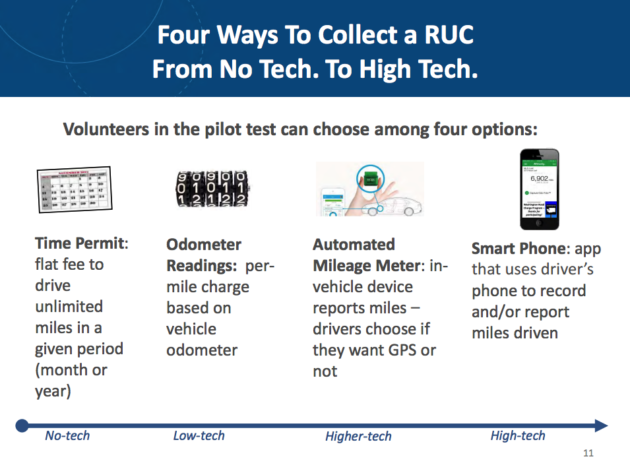
OLYMPIA, Wash. — For years, experts have debated how more fuel-efficient cars will affect the multibillion-dollar revenue stream from Washington state’s gasoline tax. Starting next year, we’ll find out.
The Washington State Transportation Commission is gearing up for a one-year study to figure out ways to charge vehicle owners a tax based on the number of miles driven within the state, rather than on the amount of gas pumped.
The state plans to seek out and select 2,000 drivers next spring, scattered across metropolitan and rural areas, to take part in the pilot project starting next fall. Officials already have set up a website – WaRoadUsageCharge.org – that will let residents sign up. The state has received more than $3.8 million in federal funding to test such alternative methods of funding highways.
The impetus for the test is the rise of electric cars, hybrids and other fuel-efficient vehicles, said Reema Griffith, the Transportation Commission’s executive director.

These vehicles are expected to fill up our roads in the next 20 years. One side effect: Less gas being pumped means less gasoline tax for the state of Washington. That translates to less revenue available for hundreds of road projects in the state. The tax went up to 49.4 cents a gallon this year, and it’s projected to generate $3.1 billion in revenue for the current budget period.
PREVIOUSLY: Making sense of Seattle’s ‘Mercer Mess,’ and the tech boom’s impact on urban infrastructure
Washington state’s test comes as the Seattle region’s population swells as a result of the technology boom. Tech giants such as Microsoft and Amazon, along with a growing number of tech startups, are attracting large numbers of workers — and their cars — to the region. The influx continues to impact major roadways and corridors in areas including the South Lake Union neighborhood, home to Amazon’s headquarters.
The pilot project will study whether a road-usage tax could be a workable alternative to the gas tax. The methods to measure road-usage will include both high-tech and low-tech approaches, Griffith said. While the exact methods have not been nailed down yet, these are some of the possibilities that have been discussed.
- A driver pre-paying for a block of miles with a simulated tax of 2.4 cents per mile. Trying out this method would test how to levy a road-use tax on vehicles with no high-tech features. Another idea that has been discussed is a time-based permit — paying a flat fee to drive unlimited miles in a given period, say, a month or a year.
- Using a smartphone to photograph the odometer reading and VIN number of a car at regular intervals — and then transmitting that information to the state.
- Attaching a mileage meter to a vehicle that would transmit information to the state automatically.
- Attaching a mileage-and-location meter to a vehicle to track in-state and out-of-state miles, so that drivers are only taxed for miles driven in Washington. This could require a multistate network for collecting and sifting taxes also be a tax-collecting-and-sifting factor if Oregon, California and British Columbia also adopt this type of road-tax system. These governments are pondering whether to adopt such a system.

After the test runs end in the fall of 2018, Griffith speculated that the data-crunching will take another nine months. Also after the test runs, the commission also will have to hold sessions with the public to get feedback. She estimated that believed it would take about three years of study before the commission can submit a report to the Washington Legislature and let lawmakers decide whether to to see if the state should pursue this concept further.
Griffith said privacy concerns have not surfaced yet on the state collecting transmitted driving data. “It is a legitimate question,” she added.
Right now, California is conducting a similar set of data-collection runs with 5,000 drivers, which is scheduled to end in spring 2017. Oregon also has a similar project under way with roughly 1,200 drivers. Hawaii will start a study similar to Washington’s pilot program in the fall of 2017.
The concept, Griffith said, “is slowly gaining momentum.”



